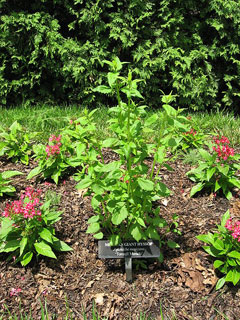 |
|
http://en.wikipedia.org/wiki/User:Chhe |
 |
|
Translate this page:
Summary
Mexican Giant Hyssop has young lemon-scented leaves with similar uses to the Korean Mint (Agastache rugosa). The leaves and flowers smell and taste of lemon and are added to salads or as a flavouring in cooked foods, including pizza, cookies, desserts and acid fruits. Chew the flowers raw straight from the plant for a lovely sweet flavour. Leaves make a pleasant tea. The aroma becomes weaker in shady conditions. It’s native to southern North America. It thrives in semi-arid regions. The larger New Mexico Giant Hyssop (A. neomexicana) growing to 1.2 m (4ft) is less popular and, with highly aromatic young leaves, used as a flavouring in cooked dishes. Leaves and flowers can be harvested from mid-summer to early autumn when the plant is in full bloom. The highly edible Anise Hyssop (A. foeniculum) has spring interest but poor heat tolerance. They are excellent bee attractants.
Physical Characteristics

 Agastache mexicana is a PERENNIAL growing to 0.8 m (2ft 7in) by 0.3 m (1ft) at a medium rate.
Agastache mexicana is a PERENNIAL growing to 0.8 m (2ft 7in) by 0.3 m (1ft) at a medium rate.
See above for USDA hardiness. It is hardy to UK zone 7. It is in flower in August, and the seeds ripen in September. The species is hermaphrodite (has both male and female organs) and is pollinated by Bees. The plant is self-fertile.
It is noted for attracting wildlife.
Suitable for: light (sandy) and medium (loamy) soils and prefers well-drained soil. Suitable pH: mildly acid, neutral and basic (mildly alkaline) soils. It cannot grow in the shade. It prefers dry or moist soil.
UK Hardiness Map
US Hardiness Map
Synonyms
Plant Habitats
Cultivated Beds;
Edible Uses
Edible Parts: Leaves
Edible Uses: Tea
The highly aromatic young leaves are used as a flavouring in salads and cooked foods[183]. The young leaves are used to make a herbal tea[183].
References More on Edible Uses
Medicinal Uses
Plants For A Future can not take any responsibility for any adverse effects from the use of plants. Always seek advice from a professional before using a plant medicinally.
None known
References More on Medicinal Uses
The Bookshop: Edible Plant Books
Our Latest books on Perennial Plants For Food Forests and Permaculture Gardens in paperback or digital formats.

Edible Tropical Plants
Food Forest Plants for Hotter Conditions: 250+ Plants For Tropical Food Forests & Permaculture Gardens.
More

Edible Temperate Plants
Plants for Your Food Forest: 500 Plants for Temperate Food Forests & Permaculture Gardens.
More

More Books
PFAF have eight books available in paperback and digital formats. Browse the shop for more information.
Shop Now
Other Uses
Are there any agroforestry uses?
Mexican Giant Hyssop is beneficial for pollinator gardens and can enhance biodiversity in agroecosystems. It can also be used as a companion plant to attract beneficial insects.
1. Nectary - Flowers rich in nectar and pollen:
Yes – It produces aromatic flowers that are rich in nectar, attracting various pollinators, including bees and butterflies.,which attract
2. Wildlife - Food (Fruit, Seeds, Leaf litter, Shelter, Nesting, Roosting):
Yes – The leaves are edible and can be used in salads or as a flavouring. The plant also provides some cover and habitat for small wildlife, but it does not serve as a significant nesting site., the
3. Invertebrate Shelter (Overwintering sites, Leaf litter, Groundcover):
Yes – It can provide shelter for beneficial insects. Its dense foliage may also offer some overwintering sites for invertebrates.
4. Pest Confuser (Smell):
Yes – The aromatic foliage can help deter certain pests due to its strong minty fragrance, which may confuse or repel insects.
Special Uses
Attracts Wildlife
References More on Other Uses
Cultivation details
A perennial plant. It can be grown as an annual. Prefers a warm, sunny, sheltered position and well-drained soil. Succeeds in most soils. Although given a hardiness rating of 9 in [200] (which means that a plant is not very frost-tolerant), this species is thriving in a sunny bed at Kew Botanical Gardens and so should be hardy to at least zone 7[K]. Another report says that it withstands temperatures down to about -40°c when dormant. Yet another report says that it should succeed outdoors in the milder and drier counties but that it is not very long-lived[233]. The flowers are very attractive to bees. The flowers are pink or red. Leaves and flowers can be harvested from mid-summer to early autumn when the plant is fully blooming.
Agastache mexicana usually flowers from mid-summer to early autumn. This plant has a moderate growth rate, reaching full size in about 2-3 years under optimal conditions.
References Carbon Farming Information and Carbon Sequestration Information
Temperature Converter
Type a value in the Celsius field to convert the value to Fahrenheit:
Fahrenheit:
The PFAF Bookshop
Plants For A Future have a number of books available in paperback and digital form. Book titles include Edible Plants, Edible Perennials, Edible Trees,Edible Shrubs, Woodland Gardening, and Temperate Food Forest Plants. Our new book is Food Forest Plants For Hotter Conditions (Tropical and Sub-Tropical).
Shop Now
Plant Propagation
Seed - sow spring in a greenhouse and only just cover the seed. The seed usually germinates in 1 - 3 months at 13°c[133]. Prick out the seedlings into individual pots when they are large enough to handle and grow them on in the greenhouse for their first year. Plant out in late spring or early summer[K]. Division in spring. Fairly simple, if large divisions are used it is possible to plant them straight out into their permanent positions. Basal cuttings of young shoots in spring[111]. Harvest the young shoots when they are about 10 - 15cm tall and pot them up in a lightly shaded position in a greenhouse. They should root within 3 weeks and can be planted out in the summer or following spring.
Other Names
If available other names are mentioned here
Mexican Hyssop, Mexican Lemon Hyssop, Lemon licorice mint, Mexican giant hyssop [1-4].
Native Range
NORTHERN AMERICA: Mexico, San Luis Potosí, Tamaulipas, Zacatecas, Guanajuato, Hidalgo, México, Michoacán de Ocampo, Morelos, Puebla, Querétaro, Tlaxcala, Veracruz de Ignacio de la Llave, Ciudad de México,
Weed Potential
Right plant wrong place. We are currently updating this section.
Please note that a plant may be invasive in one area but may not in your area so it's worth checking.
Conservation Status
IUCN Red List of Threatened Plants Status :

Growth: S = slow M = medium F = fast. Soil: L = light (sandy) M = medium H = heavy (clay). pH: A = acid N = neutral B = basic (alkaline). Shade: F = full shade S = semi-shade N = no shade. Moisture: D = dry M = Moist We = wet Wa = water.
Now available:
Food Forest Plants for Mediterranean Conditions
350+ Perennial Plants For Mediterranean and Drier Food Forests and Permaculture Gardens.
[Paperback and eBook]
This is the third in Plants For A Future's series of plant guides for food forests tailored to
specific climate zones. Following volumes on temperate and tropical ecosystems, this book focuses
on species suited to Mediterranean conditions—regions with hot, dry summers and cool, wet winters,
often facing the added challenge of climate change.
Read More
Expert comment
Author
(Kunth.)Link.&Epling.
Botanical References
Links / References
For a list of references used on this page please go here
Readers comment